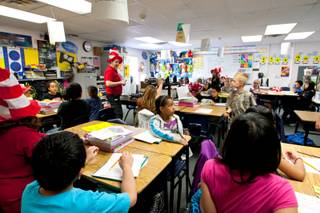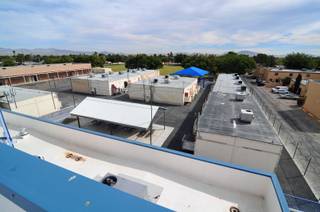
Pat Skorkowsky, Clark County School District superintendent, responds to a question during an editorial board meeting at the Las Vegas Sun offices in Henderson June 11, 2013.
Published Thursday, Feb. 13, 2014 | 5:30 p.m.
Updated Thursday, Feb. 13, 2014 | 7 p.m.
Ten additional Clark County elementary schools will switch to a year-round calendar this fall to combat classroom crowding.
The 10 schools that will go year-round next school year
• Clyde Cox
• Craig
• Dearing
• Fine
• Lake
• Ries
• Ronzone
• Roundy
• Woolley
• Wynn
More days at Zoom schools
Superintendent Pat Skorkowsky also announced Thursday that the district’s 14 “Zoom” schools serving English-language learner students will offer 17 additional days of instruction, starting in June.
The 17 additional school days are not mandatory but were recommended by the Nevada Legislature to help non-English-speaking students catch up to their literate peers.
Students attending “Zoom” schools Craig and Ronzone, which are among the 10 new year-round schools, can attend the 17 additional days of school in June, before they transition to a year-round schedule in the fall.
Clark County Schools Superintendent Pat Skorkowsky announced this evening that students at the following schools would attend classes on five different “tracks,” with one track of students on break at any given time.
Officials said the 10 schools were chosen because they were over capacity and officials could not find adequate rezoning options to mitigate student crowding. Administrators looked at several factors, including projected student population, seat capacity, school design and future growth across the valley.
The new year-round schools, which each have 800 to 1,000 students, are located in the southwest, northwest and central parts of the valley.
Going to a year-round calendar will help alleviate crowded classes by decreasing the number of students on campus by about 20 percent. All students will still receive 180 days of instruction, but will take breaks at different times during the year.
The decision will cost the district $3.08 million, or $308,000 per school, Skorkowsky said. The money will come out of the district's general fund, which means cuts will have to be made elsewhere, he added.
"The Clark County School District has gained more than 6,000 students during the past two years," Skorkowsky said. "If we filled every empty seat in all of our elementary schools, we could build 23 new elementary schools and fill them immediately. The enrollment gains in our elementary schools are creating congestion, packed classrooms and potential safety issues."
As the Las Vegas economy begins to recover, new homes are being developed across the valley, bringing new families to Clark County. The School District is struggling to accommodate its growing enrollment, which hit a record 314,643 students this year.
Officials say the district’s 217 elementary schools are on average 14 percent over the building capacity. The most crowded campuses have nearly double the number of students the building was designed to hold.
“We’ve come to a point where we have to make some tough decisions,” Skorkowsky said. “There’s no end in sight for growth. It’s out of our control.”
Although schools are brimming with students, money for new school construction is nearly depleted. The district’s last capital program, approved by voters 15 years ago, has $47 million left. That’s enough to build two new elementary schools, but not enough to handle future enrollment growth.
"Without funds to build new schools, our choices are limited," Skorkowsky said. “We have to provide seats for these children. We’re in a challenging time right now.”
To combat growth, the district plans to purchase up to 100 portable classrooms, cafeterias and bathrooms over the next two years. These portables would join more than 1,660 existing portables — the equivalent of nearly 40 additional schools.
However, space for portable classrooms on existing campuses is running out. In recent years, district officials have looked at more drastic measures to relieve student crowding: rezoning and year-round schedules.
Over the years, the district has rezoned thousands of students from crowded campuses to less crowded ones. Later this month, the School Board is expected to vote on rezoning proposals affecting nearly 1,000 students at 14 schools.
Last year, the School District announced three southwest valley elementary schools would go to a year-round schedule during the 2013-14 academic year: Forbuss, Reedom and Wright.
Earlier this school year, the district considered year-round schedules for up to 65 campuses. As an attendance zone committee looked at rezoning options, the list of 65 schools were whittled down to 39 campuses. Ten of those schools are going year-round next year.
Skorkowsky warned that families of students at 29 campuses that were spared from year-round schedules shouldn’t breathe a sigh of relief yet.
“It’s a reprieve for one year,” Skorkowsky said. “We may be in the same situation next year. There is no relief in sight.”
Over the coming months, the School Board is considering another tax initiative or bond program that could go before voters in 2014 or 2016.
The district’s last ballot measure — called Question 2 — failed to gain voter approval in 2012 by a margin of 2 to 1. Had it passed, the property tax increase would have raised $720 million over six years for school facilities.
Skorkowsky said he plans to advocate for a new capital program that would renovate aging schools and build new campuses.
"Converting schools to a year-round calendar or rezoning attendance zones are only temporary, Band-Aid solutions," Skorkowsky said. "We're going to have to build additional schools to accommodate the incredible growth we are seeing.”



Join the Discussion:
Check this out for a full explanation of our conversion to the LiveFyre commenting system and instructions on how to sign up for an account.
Full comments policy